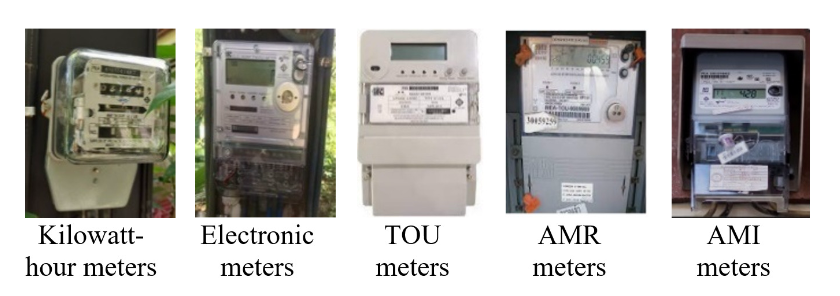Feature Extraction of Risk Group and Electricity Theft by using Electrical Profiles and Physical Data for Classification in the Power Utilities
Main Article Content
Abstract
Non-technical loss (NTL) is one of the problems that has been a major issue in lost revenue for many years. Electricity distributors have attempted to reduce NTL by detecting electricity theft using various methods. Some events are difficult to detect that conventional meters inspection is inadequate. Moreover, many anomaly patterns found are very complex, confusing in identifying or distinguishing what types of electricity customers are at abnormal risk or energy theft that affects NTL. This paper proposes five key feature extraction methods and six classifying electricity customers using supervised learning. The main problem was studied and collected information, including kilowatt meters, electronic meters, TOU meters, and AMR meters, which cover four customer types that were recorded in the Provincial Electricity Authority (PEA) of Thailand. An electrical profile to be extracted for in-depth analysis of the behavior of each type of electricity customer, combined with the information of physical data to help enhance and increase efficiency. All features examined the relationships in each feature using Pearson correlation and handled unbalanced data using random oversampling (ROS). Then, the extracted data has been trained, validated, and tested to classify three classes: normal, risk, and theft, where we evaluate the results with performance metrics. The results show that random forest (RF) outperforms the rest of the classifiers by achieving a precision-recall area under the curve of 90% and a receiver operating characteristic curve of 78%. Significantly, the results were compared to previous studies and benchmark datasets, which revealed that the proposed method gave better results than other techniques.
Article Details

This work is licensed under a Creative Commons Attribution-NonCommercial-NoDerivatives 4.0 International License.
References
M. E. De Oliveira, A. Padilha-Feltrin and F. J. Candian, “Investigation of the Relationship between Load and Loss Factors for a Brazilian Electric Utility,” 2006 IEEE/PES Transmission & Distribution Conference and Exposition: Latin America, Caracas, Venezuela, pp. 1-6, 2006.
G. M. Messinis and N. D. Hatziargyriou, “Review of non-technical loss detection methods,” Electric Power Systems Research, vol. 158, pp. 250-266, May 2018.
Performance report according to the PEA operational plan for the year 2021 quarter 1-4 (1 January – 31 December 2021), Available from https://www.pea.co.th/en/About-PEA/Operating-Results/Performance-Report.
Provincial Electricity Authority, Knowledge of loss of electricity, One Point Knowledge, OPK Code 59120015, 22 Mar 2016, pp.1-22.
Provincial Electricity Authority (PEA), Provincial Electricity Authority Regulations On the practice of meters, 2019.
J. L. Viegas, P. R. Esteves, R. Melicio, “Solutions for detection of non-technical losses in the electricity grid: A review,” Renewable Sustainable Energy Reviews, vol. 80, pp. 1256–1268, 2017.
B. C. Costa, B. L. a. Alberto, A. M. Portela, W. Maduro, O. Eler, andB. Horizonte, “Fraud Detection in Electric Power Distribution Networks Using an ANN-Based Knowledge-Discovery Process,” International Journal of Artificial Intelligence & Applications (IJAIA), vol. 4, no. 6, pp.17–23, 2013.
P. Glauner et al., ”Large-scale detection of non-technical losses in imbalanced data sets,” 2016 IEEE Power & Energy Society Innovative Smart Grid Technologies Conference (ISGT), Minneapolis, MN, USA, pp. 1-5, 2016.
P. Glauner, J. A. Meira, L. Dolberg, R. State, F. Bettinger and Y. Rangoni, “Neighborhood Features Help Detecting Non-Technical Losses in Big Data Sets,” 2016 IEEE/ACM 3rd International Conference on Big Data Computing Applications and Technologies (BDCAT), Shanghai, China, pp. 253-261, 2016.
J. Nagi, K. S. Yap, S. K. Tiong, S. K. Ahmed, and M. Mohamad, “Nontechnical loss detection for metered customers in power utility using support vector machines,” IEEE Transactions on Power Delivery, vol. 25, no. 2, pp. 1162–1171, 2010.
J. I. Guerrero, I. Monedero, F. Biscarri, J. Biscarri, R. Millan, and C. Leon, “Non-Technical Losses Reduction by Improving the Inspections Accuracy in a Power Utility,” IEEE Transactions on Power Systems, vol. 8950, no. c, pp. 1–11, 2017.
M. Buzau,J.Aguilera, P.Romero,and A.G ́omezExp ́osito, “Detection of Non-Technical Losses Using Smart Meter Data and Supervised Learning,” IEEE Transactions on Smart Grid, vol. 7, no. 1, pp. 216–226, 2016.
Z. Zheng, Y. Yang, X. Niu, H. -N. Dai and Y. Zhou, “Wide and Deep Convolutional Neural Networks for Electricity-Theft Detection to Secure Smart Grids,” in IEEE Transactions on Industrial Informatics, vol. 14, no. 4, pp. 1606-1615, April 2018.
V. Ford, A. Siraj, and W. Eberle, “Smart Grid Energy Fraud Detection Using Artificial Neural Networks,” no.1, pp. 0–5, 2014.
C. Cody, V. Ford and A. Siraj, “Decision Tree Learning for Fraud Detection in Consumer Energy Consumption,” 2015 IEEE 14th International Conference on Machine Learning and Applications (ICMLA), Miami, FL, USA, pp. 1175-1179, 2015.
J. No, S. Y. Han, Y. Joo, and J.-H. Shin, “Conditional abnormality detection based on AMI data mining,” IET Generation, Transmission & Distribution, vol. 10, no. 12, pp. 3010–3016, 2016.
P. Jokar, N. Arianpoo, and V. C. M. Leung, “Electricity theft detection in AMI using customers’ consumption patterns,” IEEE Transactions on Smart Grid, vol. 7, no. 1, pp. 216–226, 2016.
J. A. Meira et al., “Distilling providerindependent data for general detection of nontechnical losses,” 2017 IEEE Power and Energy Conference at Illinois (PECI), Champaign, IL, USA, pp. 1-5, 2017.
. N. Toma, M. N. Hasan, A. -A. Nahid and B. Li, “Electricity Theft Detection to Reduce Non-Technical Loss using Support Vector Machine in Smart Grid,” 2019 1st International Conference on Advances in Science, Engineering and Robotics Technology (ICASERT), Dhaka, Bangladesh, pp. 1-6, 2019.
S. Aziz, S. Z. Hassan Naqvi, M. U. Khan and T. Aslam, “Electricity Theft Detection using Empirical Mode Decomposition and KNearest Neighbors,” 2020 International Conference on Emerging Trends in Smart Technologies (ICETST), Karachi, Pakistan, pp. 1-5, 2020.
R. Yadav, Y. Kumar, “Detection of nontechnical losses in electric distribution network by applying machine learning and feature engineering,” Journal European des Systems Automatizes, vol. 54, no. 3, pp. 487-493, June 2021.
L. J. Lepolesa, S. Achari and L. Cheng, “Electricity Theft Detection in Smart Grids Based on Deep Neural Network,” in IEEE Access, vol. 10, pp. 39638-39655, 2022.


